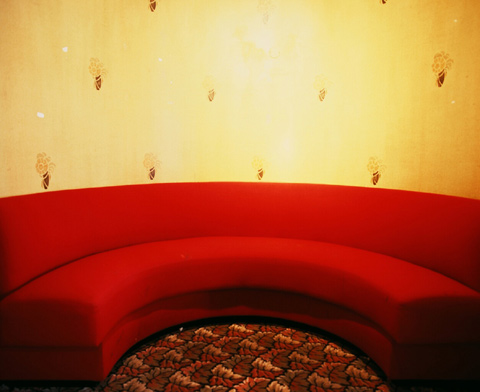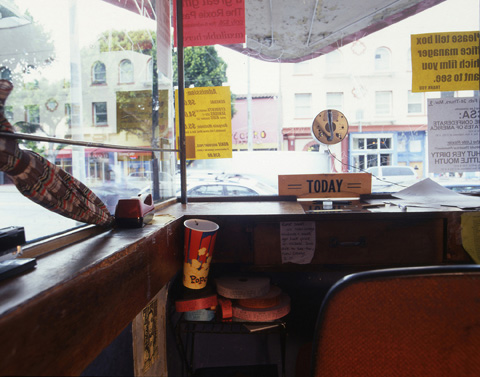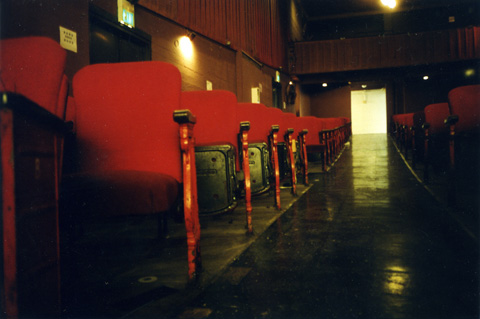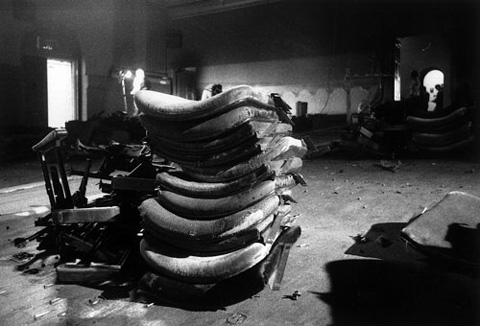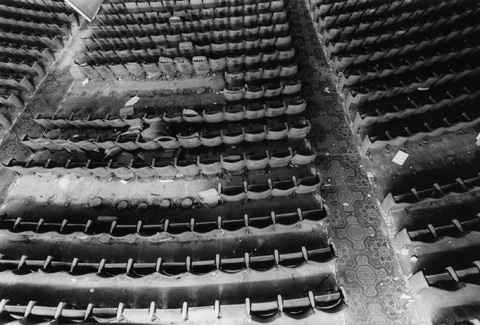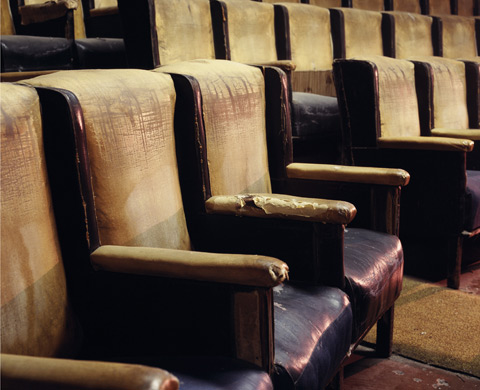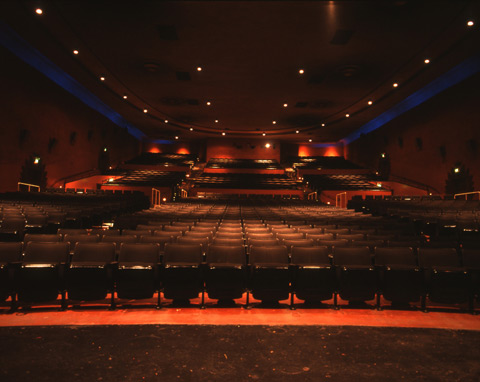Exposure to the Dark by Julie Lindow, with photography by R.A. McBride
San Francisco is extremely fortunate to still have so many of the movie theatres
that were built between 1920—1950 including the Castro, Balboa, Bridge, Roxie,
Clay, and Harding, to name just a few. Monuments to our cultural heritage,
these theatres embody some of San Francisco's most gorgeous architecture, house
our rich film scene, and help to build the city's character. Photographer Rebecca
McBride and I have set out to document these common spaces, both decaying and
vital, in our forthcoming book, Left in the Dark: Portraits of San Francisco
Movie Theatres.
On a similar quest, filmmaker Christian Bruno is currently
producing the film, STRAND: A Natural History of Cinema. Through stunning
imagery, interviews, and text by cultural leaders these projects expose the
crucial role theatres and independent cultural spaces play in a democracy.
As we know, democracy is dependent on a citizenry that is exposed to a diversity
of views from a diversity of sources, news, books, film, theatre, art, radio,
and television.
next... /
/ back...
Our media complex is controlled by a few large corporations
with little interest in anything except their bottom line. The demands of the
military-industrial-complex-driven market do not allow corporations to
factor greater social wellbeing into their figures. We are experiencing market
censorship of cultural production on a grand scale. Censoring Culture, Contemporary
Threats to Free Expression, co-edited by Robert Atkins and Svetlana Mintcheva,
does a fine job of explaining how market censorship works. In the past ten
years the number of independent bookstores has diminished from 5,400 to 3,200. A
Clean Well Lighted Place for books on Van Ness Ave. and Acorn Books on Polk
Street, both in San Francisco, will close this year. High rent and limited
National Endowment for the Arts and public funds have caused many small arts
organizations to close over the past ten years. Similar to the major book publishers,
the big film studios are allowing old films to decay and not taking risks on
artistic or independent productions because the profit margin is so small.
Neighborhood movie theatres are closing in the face of home entertainment systems
and Hollywood multiplexes. Sure the web is flooded with information, but when
it is not curated, it is too easy for a seeker to drown. Sure you can rent
almost any film you want online, but exposure to views that one does not seek,
art that is odd, books that seem too experimental, films that make no sense,
the hole in the wall gallery, a community that inspires you to think along
new lines, creates possibilities for growth. Without such exposure we would
not be able to imagine a future other than the monocultural, environmentally
destructive path that we are currently on. Cultural production is like an ecosystem—it
requires a great diversity of venues and platforms for community, discourse,
creation, distribution, and room for chance encounters.
next... /
/ back...
Rebecca Solnit (in an interview with Christian Bruno that will be featured
in his film and transcribed for our book) refers to the current value system
as a "tyranny of the quantifiable." We are taught to worship "efficiency, convenience,
and privacy." We cannot hide in the alienation of home entertainment systems,
cars, gated communities and still thrive as a democracy. Interestingly, people
in cities—which are targets for terrorism—are less afraid of the world, of
foreigners, and new ideas, than those living in areas that are not at risk.
We need exposure to new ideas and to each other—the strangers on the street,
in line at the post office, sitting next to one another in the movie theatre.
When we sit next to a stranger in a movie theatre they may laugh or be dismayed
at different parts of the film than we are, which might expand our own experience
of the film. Also, when large groups of citizens see the same films, they have
common ground to discuss, inspiring civic discourse to ensue.
Ian Breakwell & Paul Hammond put it well in their book, Seeing in
the Dark:
" . . . there is something about the cinema that encourages, right there
in the picture house, thoughts, feelings, and behaviour in its patrons by turns
enigmatic, terrifying, erotic, sad, hilarious and poetic, often triggered by
uncanny interplay between screen image and real-time events in the auditorium
and in the world beyond the muffled doors. 'Alone in a crowd' is never so intense
as at movies, and never so open to sudden dislocation. It is the complex play
between me, you, them, the film, the cinema building and the world outside
that enables us, on occasion, to experience reality more completely, and as
in dreams to see in the dark."
next... /
/ back...
The decline of neighborhood movie houses significantly impacts San Francisco's
character. Between 1910 and 1930 dozens of neighborhood movie houses rose as
central landmarks on commercial strips that radiated along streetcar lines
out from the center of the city. Neighborhoods blossomed in concentric patterns
around each theatre. These focal points enabled San Franciscans from all walks
of life to meet in the commons, in public dreams. The place to be seen on a
weekend night was under the larger-than-life Hollywood titles of a Market Street
marquee along the line of bright theatres on the "Great White Way", which showed
first-run films. In contrast, the neighborhood theatres functioned as communal
living rooms, and showed mostly second and third-run films. After their glory
days, most of the theatres became second-run, then maybe a repertoire or art
house, then they would show porn to get by.
The new cinemas, opening soon on Market Street near Powell, will be controlled
by large corporations. They will not be community centers with owners who stand
in the lobby polling their customers about what color carpet they like best
or describe their top foreign-film-festival picks to their audiences. The new
cinemas have announced that their programming will include independent artistic
films, but most likely their investors will demand quick return, which means
that the curatorial process will not have room to build audiences' appreciation
of less familiar directors, genres, and styles.
Small independent businesses unlike cookie-cutter chains are usually run by
local families with a vested interest in their neighborhoods. The new cinemas
will not have such community figures as Gary Meyer, owner of the Balboa Theatre,
and one of the Left in the Dark authors.
next... /
/ back...
As Gary has explained, market
forces are making it almost impossible for small houses to financially exist
without additional sources of income such as a cafe, pizza and beer, or donations.
Films are now released for rental only weeks after their release in the theatres;
thus second-run films have less and less audience. Many foreign films are not
even being distributed for screening—only as rentals. It is becoming less and
less convenient for audiences to make their way to the theatre. In addition
the historic buildings which house the independent theatres are crumbling,
in need of more repair than most small businesses can afford.
A couple years ago Rebecca McBride and I met at filmmaker Melinda Stone's
ranch in northern California. Many San Francisco filmmakers, writers, and
artists had gathered for a week away from the city. I had been thinking about
comprising a book about San Francisco's old theatres, a book that would explain
why small cinemas and arts venues are critical to our quality of life in San
Francisco and to a our democracy.
Rebecca McBride had been photographing the old theatres because she felt a
great urgency to document them before they were gone forever, like the giant
redwoods. Her work co-producing a series of slide show events outdoors and
in galleries with Point Blank, a San Francisco photography group, informed
her thinking about the need for independent cultural spaces and the loss the
city was experiencing. Her experience documenting the most significant moments
of peoples' lives, childbirth and weddings primarily, contributed to her amazing
ability to capture the transformation of these theatres—from vibrant palaces
to tattered porn or art houses.
next... /
/ back...
Rebecca's photographs stunned me. I had seen several coffee table books with
photos of old theatres but nothing as finely crafted, raw and polished, as
Rebecca's images. Her series of the Castro theatre's chair renovation reveals
metamorphosis. It is one thing to document architectural heritage with straightforward
shots and another to reveal its histories and meaning. Inspired by Hiroshi
Sugimoto, Sally Mann, and Mary Ellen Mark, her shots of vacant chairs, projection
and ticket booths, blank screens and restroom signs, to name just a few architectural
remnants, capture the evidence of life happening there as well as the work
and play exposed in the pealing paint and worn armrests. Looking at her photos
you feel the stillness after the storm of their vital years—like the moment
of silence in mourning or the awe after a roar of applause.
We decided that weekend at the ranch that we should produce a photography
book together that has since been titled, Left in the Dark: Portraits of
San Francisco Movie Theatres. Also, at the ranch was San Francisco filmmaker
Christian Bruno who Rebecca had been coat-tailing to get access to the theatres.
They have photographed and filmed over a dozen theatres.
Christian's one-hour documentary, STRAND: A Natural History of Cinema documents
San Francisco's rich movie-going heritage through breathtaking new and archival
footage, oral histories, and an original score by the neo-classical ensemble,
Rachel's. By exploring the disappearance of the city's movie houses he raises
questions about the loss of public space.
next... /
/ back...
He interviews people who were specifically
involved in film exhibition such as Greg King and Mike Thomas who ran the Strand
for many years; Jack Tillmany, who ran the Gateway for many years, became a
historian, and recently published a book Theatres of San Francisco;
as well as Anita Monga, former programmer for the Castro who currently co-curates
the Noir City film festival. STRAND is also about the city and how
theatres closed because of the post-WWII flight to the promised-land of the
suburbs. Talking on camera about these larger issues are Rebecca Solnit, Walter
Murch, and James Kunstler.
Together our projects have become an amazing process in building community
and recovering threatened history. There is strength in numbers, a diversity
of viewpoints and medias by which the projects are manifesting. The book project
is complemented by exhibitions of Rebecca's large scale photos, a slide show
with an original soundtrack by Steven Dye, articles such as this, and events
such as the benefit we held at Foreign Cinema in May 2006 which also included
live music and a preview clip of Christian's film.
Left in the Dark will be compromised of about fifty photographs and
ten chapters bringing together such cultural leaders as Rebecca Solnit, Liz
Keim, Joshua Grannell (also known as Peaches Christ), Anita Monga, Gary Meyer,
and Eddie Muller. Each author has worked to expose audiences to new or forgotten
films thus helping to shape San Francisco's film scene. In their contributions
they will draw from their personal experiences and connections to reveal the
hidden histories behind San Francisco's theatres.
next... /
/ back...
Liz Keim has been programming the film series at the Exploratorium for the
past 20 years. She has exposed a lot of people to the wonders of experimental
films and is writing about the experimental film scene that thrived in San
Francisco from 1960-1980. She describes how neighborhood theatres could not
survive by showing experimental films alone, so they often also screened porn.
As a result, the experimental films took on an air of being more exotic, mysterious
and less elitist than if they had only been shown in galleries or museums.
Joshua Grannell, aka Peaches Christ, is the manager of the Bridge Theatre
and creator of Midnight Mass. Joshua and his co-worker, historian Elisabeth
Houseman, are writing a chapter about the history of performance and film—from
the Cockettes to his own experiences producing and performing the Midnight
Mass film series. He explains how going on the road with Midnight Mass made
him realize how the city's tradition of audience participation at film-performance
events is part of San Francisco's unique character.
Eddie Muller, the "Czar of Noir," has exposed audiences to lost or forgotten
noir films and revived interest in the genre through his books Dark City,
Dark City Dames, The Art of Noir, and the Noir City film festival, among
other projects. He has been so successful in building interest that he founded
the Film Noir Foundation] to raise funds to preserve decaying noir films. He
will write about his own experiences growing up in San Francisco's neighborhood
movie houses and how noir reveals the city as an alternative to the post-WWII
suburban promise.
next... /
/ back...
Anita Monga currently works with Eddie Muller co-curating film noir festivals.
She is well-known in San Francisco for her reign at the Castro Theatre as programmer
and curator for over fifteen years. Her career began as a programmer at the
Roxie until 1984 when she moved over to the York Theatre. Along with her carefully
chosen premieres, she launched Film Noir Mondays, director tributes and the
breakthrough Women in Film festival. Her chapter will focus on how audiences
are built, and the importance of theatres where film is curated and not simply
programmed for a profit.
When movie theatres first became popular around 1910 they were heralded as
a way for the working masses to be educated. For the first time people with
poor reading skills and minimal education could be exposed to far away lands,
cultures, international news reels, wild creatures, etc. Movie going is still
one of the most popular and affordable activities for families. As producers
of culture we have an obligation to defeat the myth that the market is democractic
and reveal how desire is manufactured. Audiences need to be cultivated over
time—more time than corporate America's bottom-line will allow—and communities
need to be able to participate on the ground-level in their cultural common
spaces. It is our hope that Left in the Dark: Portraits of San Francisco
Movie Theatres and STRAND: A Natural History of Cinema will expose
audiences to the rich cultural heritage embodied in our gorgeous, decaying
dream palaces.
Photography by R.A. McBride and article by Julie Lindow.

